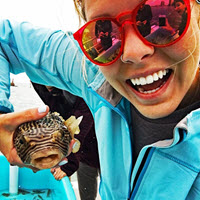
The Gulf of Mexico is one of four “super-diverse” ecoregions in the world; yet, we don’t know much about how its deep environment changed after Deepwater Horizon because very little was known about it before the spill. Since the spill, the data about deep-ocean life are growing as scientists with the DEEPEND research consortium study the deep Gulf’s organisms and processes. Their findings will help develop a baseline to monitor future changes.
Master’s-level graduate students working alongside DEEPEND scientists are writing a weekly blog series about their research contributions. “When these disasters occur, the deep sea is not often thought of – it is kind of an out of sight, out of mind situation,” said student Devan Nichols. “The deep sea is a mysterious place, and scientists still have a lot to learn about its complexity and the organisms found there.”
Here are some deep-ocean research areas that these students have written about, which can help inform management decisions to predict, protect, and increase recruitment for future populations.
Gulf Shrimp
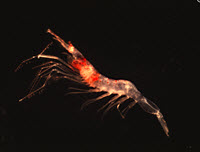
Devan Nichols, Richard Hartland, Ronald Sieber, and Nathan LaSpina at Nova Southeastern University are studying potential impacts to Gulf shrimp (family Oplophoridae, family Sergestidae, family Euphausiidae and family Benthesicymidae). They are examining data collected in 2011, comparing them to data collected in 2015, 2016, and 2017, and identifying changes in abundance, biomass (weight), and vertical migrations.
The data are beginning to show a sharp decrease in abundance between 2011 and 2015 – 2017 and that the warm water input from the Loop Current may affect abundance. Further analyses are required to verify if the Current affects migration habits.
Young Fish
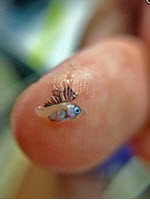
Corinne Meinert (Texas A&M University at Galveston), Sebastian Velez (Florida Atlantic University), and Nina Pruzinsky (Nova Southeastern University) are researching the biodiversity, dispersal processes, and spatial distribution of early life stage fishes.
Meinert uses genetic methods to analyze oceanic ichthyoplankton – fish eggs and larval fishes that drift in ocean currents – and learn about their biodiversity and population dynamics. This information gives insight into the status of the oceanic environment, since higher fish diversity typically indicates a healthier ecosystem.
Velez focuses on larvae from nearshore species (snappers and groupers) that utilize offshore habitats (up to 1,500 m depth). He observed strong biodiversity in these expatriates and found that some species, such as the Wenchman snapper, have the ability to stall their settlement, likely in search of a suitable habitat. “When you walk into a restaurant and order sushi or a fish dinner […] the odds against a particular animal making it to a harvestable size are astounding,” said Velez. “These fishes [often] represent multi-million dollar industries in the form of commercial and recreational fisheries. Understanding the biology and life history of [these] species is imperative in informing future management decisions.”
Pruzinsky studies the spatiotemporal distributions of early life stage tuna to learn about their habitat preferences and help compile key identification features for juvenile tuna species. These features include pigmentation patterns, body shape, ratios of different body parts, and fin ray counts. She developed high-resolution models of larval and juvenile tuna distributions as a function of habitat. These models represent some of the first for juvenile tunas (as opposed to the better-known larvae and adults).
Adult Fishes
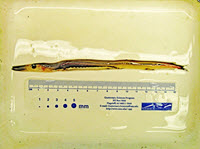
Characterizing the behaviors and distribution of deep-sea fishes is a major focus of DEEPEND. Rich Jones at Florida Atlantic University is researching the important but poorly known fish family Paralepididae (barracudina), whose unique bioluminescence is derived from liver tissues. Using data from large pelagic trawls (NRDA ONSAP sampling), he observed that barracudina actively avoid smaller, research-sized nets, suggesting that we have probably underestimated their abundances and importance historically. He also noted distinct differences in diet and water column distribution between barracudina species.
Nova Southeastern University student Kristian Ramkissoon researches the composition, abundance, and vertical distribution of the bristlemouth fish genus Cyclothone, the most abundant vertebrate on the planet. He has observed that these fishes do not vertically migrate, but instead occupy relatively predictable and distinct depth ranges. He is attempting to assess the impact of hydrographic features such as the Loop Current and its eddies on Cyclothone distribution.
Fellow Nova student Natalie Slayden studies otoliths – ear stones whose rings represent a fish’s age. She plans to describe and correlate otolith ring patterns with the fish’s life history and estimate the ages of various mesopelagic and bathypelagic fishes, most for the first time.
Max Weber at Texas A&M University at Galveston uses genetic methods to investigate if population size fluctuations in deep-sea fishes mirror those of coastal species. Stable populations reflect a stable environment, yet Max’s preliminary analyses reveal population declines and expansions that indicate the environment is more volatile than previously assumed.
Eating Habits
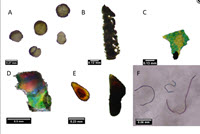
Three Nova Southeastern University students analyze fish gut contents as part of their focus on food webs. Mike Novotny is researching bathypelagic fishes called “Tubeshoulders” (family Platytroctidae) to explore their feeding behaviors and prey preferences – the first known study into the diet of this important family. He observed that these creatures are zooplanktivores that feed on gelatinous animals (e.g., jellyfishes and relatives), something not previously known.
Ryan Bos focuses on fish and shrimp ingestion of microplastics (ranging 1 μm – <5 mm), which can cause false feelings of fullness, obstruct feeding appendages, decrease reproductive fitness, and premature death. He identified microplastics (which burn, melt, curl up, or repel when touched with a hot needle) and observed that nearly one-third of the fishes and crustaceans tested ingested at least one piece of plastic. These findings highlight the ubiquitous influence of anthropogenic pollutants in the deep ocean.
Matt Woodstock is studying mesopelagic fishes to better understand the ecology of endoparasites, which live within another organism (a host) and travel through the food web to complete their life cycles. The presence of many different parasites suggests that the fish’s diet may have shifted over time or may come from many different prey. These results will help researchers make conclusions about the connectivity and stability of different ecosystems.
Rare Finds
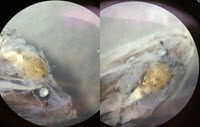
Many of the students’ research projects focus on little-studied Gulf of Mexico organisms and processes and are the first studies of their kind. For example, three of the nineteen barracudina species captured for Jones’s research represent the first records of those species, and Woodstock is the first person to record parasites within the species he studies.
“Some of the fishes we have identified have only been seen by a handful of people before in oceanographic history,” said Rich Jones. “The opportunity to study the habits of these rare animals with a comprehensive suite of data, let alone hold them in your hand, is a unique pleasure of working with DEEPEND.”
Learn more about DEEPEND research:
- Study Develops Biogeographic Classification of the World’s Deep Oceans
- Science at Sea: Deep-Sea Research Informs Taxonomic Assessment of Gulf Fauna
- Discovering Vibrant, Dynamic Life in the Deep Gulf of Mexico
- Grad Student Novotny Searches for Oil Transport Pathways in Deep-Sea Fish Stomachs
- Grad Student Max Weber Fishes for Insight into Deep-Pelagic Fish Taxonomy
- Grad Student Timm Tracks Crustacean’s Oil Spill Recovery
************
This research was made possible in part by a grant from the Gulf of Mexico Research Initiative (GoMRI) to the Deep-Pelagic Nekton Dynamics of the Gulf of Mexico (DEEPEND) consortium.
The Gulf of Mexico Research Initiative (GoMRI) is a 10-year independent research program established to study the effect, and the potential associated impact, of hydrocarbon releases on the environment and public health, as well as to develop improved spill mitigation, oil detection, characterization and remediation technologies. An independent and academic 20-member Research Board makes the funding and research direction decisions to ensure the intellectual quality, effectiveness and academic independence of the GoMRI research. All research data, findings and publications will be made publicly available. The program was established through a $500 million financial commitment from BP. For more information, visit https://gulfresearchinitiative.org/.
© Copyright 2010-2018 Gulf of Mexico Research Initiative (GoMRI) – All Rights Reserved. Redistribution is encouraged with acknowledgement to the Gulf of Mexico Research Initiative (GoMRI). Please credit images and/or videos as done in each article. Questions? Contact web-content editor Nilde “Maggie” Dannreuther, Northern Gulf Institute, Mississippi State University (maggied@ngi.msstate.edu).
